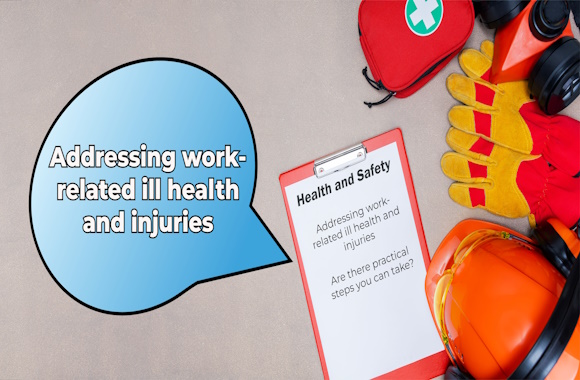Work-related ill health and injuries: Are there practical steps you can take?
The Health and Safety Executive’s (HSE) recently released annual statistics for 2023/24 reveal the challenges being faced by employers in managing work-related ill health and injuries. Stress, depression, anxiety, and workplace injuries continue to be issues affecting the health and wellbeing of workforces.
Key insights from the report
- Work-related ill health: Around 1.7 million workers suffered from work-related ill health, with 776,000 cases attributed to stress, depression, or anxiety.
- Workplace injuries: 138 workers lost their lives to work-related accidents, and 604,000 sustained non-fatal injuries.
- Economic costs: Work-related ill health and injuries cost the economy £21.6 billion in 2022/23, with an estimated 33.7 million working days lost in 2023/24.
- Trends: The rate of work-related stress, depression, and anxiety remains higher than pre-pandemic levels, despite a decrease from 2022/23.
Practical measures employers can take
These figures highlight a dual responsibility for employers: safeguarding employees’ physical health and addressing the increasing prevalence of work-related mental health challenges.
Here are some practical steps you might be able to take to help with these issues in your workplace.
- Strengthen mental health support
Depending on the size of your workforce and the costs, you might be able to consider implementing an Employee Assistance Programme (EAP). These provide confidential counselling and mental health resources to employees.
More practically, you may be able to promote work-life balance policies that increase employee wellbeing and reduce stress. For instance, you could look at flexible working arrangements, consider how you monitor and react quickly when workloads become unreasonable, and consider whether you can do things to help staff take breaks that reduce stress.
Managers may also need training so that they can identify and support employees who are experiencing mental health challenges.
- Enhance physical safety protocols
The HSE provides guides and risk assessments that can help you to identify workplace hazards and implement preventive measures. Make sure safety is not being left to chance and ensure that you have procedures in place to regularly review guidance, carry out risk assessments, and implement any adjustments needed.
Providing employees with regular training on safe practices tailored to their specific roles can also reduce safety-related problems.
Any tools and machinery used by your business should also meet modern safety standards to reduce accident risks. A program to regularly review alternatives to any dangerous equipment you use can also help.
- Address the root causes of stress and anxiety
Stress and anxiety are often exacerbated by uncertainty and a lack of transparency. Therefore, look to see that there are open lines of dialogue between management and staff that can be
used to address concerns and reduce uncertainties. Heavy workloads can also cause stress and anxiety, particularly if workers feel that tasks are not distributed fairly. So, it may be good to consider: how is work allocated? How would you know if an employee felt that excessive demands were being placed on them.
- Proactively monitor and review
Look to see if there are any patterns in sick leave that might help you identify underlying issues. This will give you the opportunity to address them early. Ask your employees for their thoughts on safety and well-being. If they feel they can speak up about issues, you are more likely to be able to sort issues before they become a problem.
- Leverage technology
New technologies are appearing all the time. Implementing those that can reduce manual, high-risk tasks will minimise injury risks to your employees. E-learning and on-demand training is now widely available, and this can be used to provide training in a cost-effective way that reinforces safety awareness.
Looking ahead
HSE’s Chief Executive Sarah Albon noted that while the UK has made significant strides in workplace safety over the past five decades, these statistics are a reminder of the need for continued vigilance and improvement. Considering what practical steps you can take to ensure the safety and well-being of your employees could pay dividends. A healthy, safe, and supported workforce isn’t just good for employees—it’s a critical component of a productive, sustainable and profitable business.
See: https://press.hse.gov.uk/




